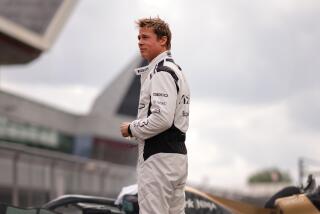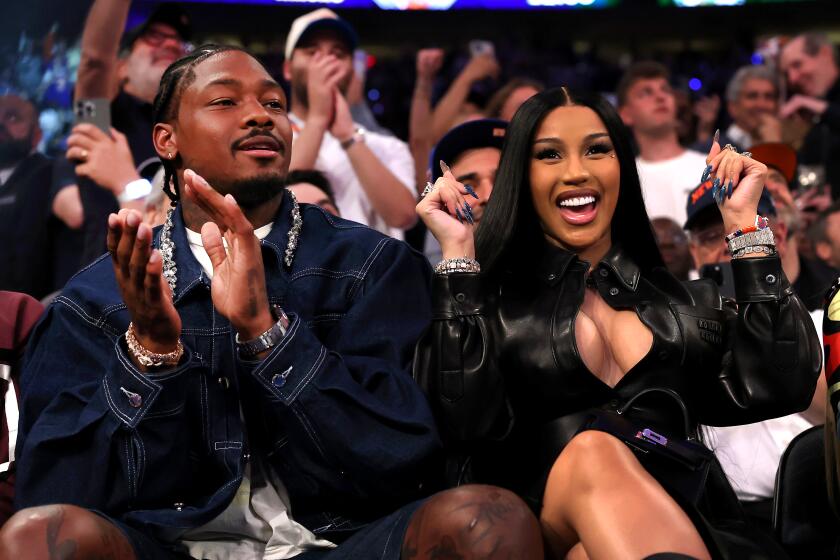Busch can’t put off Tomorrow
- Share via
BRISTOL, TENN. — Here’s how Kyle Busch, winner of the first-ever Car of Tomorrow race, reviewed the radical new design: “I’m glad to be coming out of here with a victory, but I still can’t stand to drive these things. They’re terrible.”
Busch had come on a mission into Sunday’s Food City 500 at Bristol Motor Speedway: to win and gain a forum for saying his piece.
“All weekend here, and even from the test [Feb.28-March 1 here], I said, ‘I can’t stand to drive this thing. It’s terrible. I hope we can go out and win the race and I can just tell everybody how terrible it is to drive.’ I’m serious. I told ‘em that.”
“He did,” his crew chief, Alan Gustafson, confirmed.
What Busch and his team learned racing, he said, was “kind of the same thing we already knew” from testing and practice. “It just doesn’t turn. For me it’s not very much fun to drive. It’s a hard car to be competitive with, because it just doesn’t have the maneuverability. When you start sliding somewhere, it continues to slide.
“It’s like you’re on skis out there.”
NASCAR’s vice president for competition, Robin Pemberton, responded that “everybody has an opinion, and that’s OK. I’m OK with it. It means that somebody who won the race wants to make that car better.”
Overall, Pemberton called the debut “a very successful day,” especially for the primary aim of the COT, enhanced safety.
“We had some hard impacts, and the car did what it was supposed to do as far as absorbing energy,” Pemberton said.
If Busch sounded like the least enthusiastic race winner in recent NASCAR history, there were several reasons for it. He knew he was fortunate to win on several fronts. Joe Gibbs Racing teammates Tony Stewart and Denny Hamlin led most of the laps in the first and second halves of the race, respectively, but Stewart fell out with a broken water pump and Hamlin got stuck in traffic at the end.
Busch’s biggest break came in the final seconds from veteran Jeff Burton, who finished second by two-thirds of a car length after refusing to do what is commonly done at this slam-bang little half-mile track.
“Obviously I could have used the bumper and moved him out of the way and won the race,” Burton said. “But that’s [racing clean] what I chose to do.”
Jeff Gordon, who has been known to use his bumper here to win, finished third and also could have laid into Busch to take the lead on the final restart (a green-white-checkered overtime).
“But I knew Jeff would have gotten an earful, if he’d laid the bumper to us, from our boss over here,” Busch said, gesturing toward their team owner, Rick Hendrick.
Gordon also found a technical reason to lay off.
“These bumpers certainly line up a lot different” from the traditional cars, he said. “In the past, when you got a bumper on a guy, it really lifted the back of his car. These cars push it forward.”
Only from hearing drivers talk could you tell the COT debut was any different from any Nextel Cup race at Bristol. There was a normal -- for here -- number of cautions, 15, with the usual spinouts and fender-banging. From high in Bristol’s 160,000-seat grandstands, which were packed, the cars didn’t look much different from the usual field.
Only the high rear wings were noticeable, and the adjustable front aerodynamic wings were barely visible to the naked eye.
And indeed, “I thought it was really similar to a normal Bristol race,” said Burton, who was as diplomatic off the track as he had been on it.
“Certainly these cars don’t drive as well as the cars we had here last year,” Burton said. “But they are what they are.”
Ed Hinton covers motor sports for Tribune Co. newspapers.
*
(BEGIN TEXT OF INFOBOX)
Glimpse at future
Looking at the issues raised by the Car of Tomorrow’s debut:
Question: How was the Car of Tomorrow better at Bristol Motor Speedway than traditional Nextel Cup cars?
Answer: It wasn’t. “It just doesn’t have the maneuverability,” said race winner Kyle Busch.
Q: Where was the COT worse at Bristol?
A: In the turns. Drivers say it has only half the down-force of traditional cars.
Q: Then why is NASCAR mandating the COT?
A: Mainly to enhance safety, especially in instances of side impact, but also to improve racing. At larger tracks than Bristol, the boxier cars should knock bigger holes in the air and enhance drafting. More versatile for the various types of tracks, the COT also is supposed to reduce costs to teams.
Q: What did teams learn from Sunday’s first experience with the COT?
A: “You know if we learn something we’re not going to say what we learned,” said Jeff Burton. “That wouldn’t be very productive.”
Q: Which teams appeared to have the jump on COT technology?
A: Chevrolet teams were strongest. Hendrick Motorsports drivers Busch and Gordon finished first and third. Richard Childress Racing’s Burton and Kevin Harvick finished second and fourth.
Q: What’s next?
A: The COT is mandatory again for next week’s race at Martinsville, Va., another half-mile track. But Martinsville is flatter than Bristol, and teams haven’t gotten a single test of the COT at Martinsville.
-- ED HINTON
More to Read
Go beyond the scoreboard
Get the latest on L.A.'s teams in the daily Sports Report newsletter.
You may occasionally receive promotional content from the Los Angeles Times.










